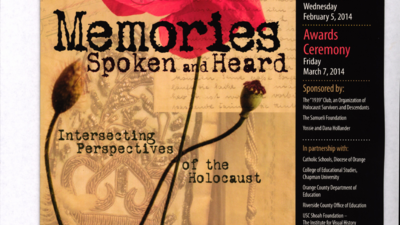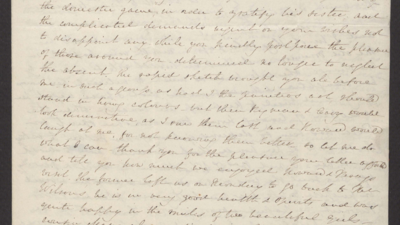Oral History Interview with Eva Cutler
Title
Date
Contributor
Summary
Eva Cutler, née Frederich, was born in 1925 in Budapest, Hungary, the second child of a cultured, Jewishly emancipated family. She describes her family’s change from being unaware of existing Hungarian antisemitism and of Nazi persecutions of Jews elsewhere, to growing dread under government imposed restrictions, almost secret attempts to emigrate, along with continuing disbelief. She tells of varied attitudes of Hungarians under German occupation and help given by some non-Jews, even a German administrator. Her brother was inducted into a work brigade and later her father was taken away.
In the fall of 1944, Eva—along with many other young Jewish women—was herded out of Budapest. She details horrendous conditions and brutality during the death march to Bergen-Belsen. She witnessed a mass execution of men. A German army officer helped her walk so she could keep going. Some townspeople offered food to the marchers, others abused them. She mentions a brief encounter with Wallenberg at the Austrian border, where he saved those who had Swiss or Swedish protective passes or said they had. Eva arrived at Bergen-Belsen in January 1945 after enduring a prolonged cattle car ride. She describes how survivors suffered from continued deprivation and illness there and also had to cope with hostility from Polish and Czech Jews already there. After liberation in April, she learns that her parents survived in Budapest and her brother is presumed dead. Eva was sent to Sweden for recovery and rehabilitation by the Red Cross. She praises the excellent medical care and kindness she experienced there. She came to the United States in 1946. Her parents came to the United States via Canada, after Eva attained U.S. citizenship. She closes with an account of her return to Hungary after 37 years and stresses the brotherhood of man.
More Sources Like This
of
Inge Karo
Inge Karo, née Heiman, was born in 1926 in Essen, Germany. Her father was part owner of a business. Her parents were active in the Jewish community and belonged to a conservative synagogue. Inge belonged to a non-Zionist youth organization and was educated in a school for Jewish children until the schools were closed by the Nazis. The effects of the Nüremberg laws, passed in 1935, are briefly described. The Jewish community of Essen and the Heiman family experienced the destruction of Kristallnacht in 1938. Nazis threatened to burn down her family’s house and then confiscated it. Inge was affected by the pervasive Nazi propaganda, the persecution, and her family’s attempts to escape from Germany to the United States. The family emigrated to the United States in December 1939. Inge briefly talks about life in the United States as a refugee, including her experiences in public school.
of
Ernest Eckstein
Ernest Eckstein served in the 93rd Heavy Mortar Battalion, U.S. 3rd Army. He arrived at Buchenwald concentration camp in April or May, 1945 and was completely unprepared for what he saw there: piles of bodies, gold teeth, hair and clothing. He describes the condition of the approximately 20,000 survivors, many of whom died after liberation. He interviewed one of the survivors through an interpreter and mentions his encounter with a Jewish survivor. He describes the barracks and finding fingermarks on the walls of the gas chambers. Buchenwald profoundly affected him and he still thinks about it every day.

This multi-page brochure announces and provides details for the 15th Annual Holocaust Art & Writing Contest, organized by Chapman University and its affiliated centers, including the Rodgers Center for Holocaust Education. The contest invites students from middle and high schools to submit original works of art, film, or writing based on Holocaust survivor testimonies. The document outlines the contest rules, submission guidelines, prizes (including a study trip to the United States Holocaust Memorial Museum in Washington, D.C.), and the awards ceremony scheduled for March 7, 2014. It emphasizes the theme "Memories Spoken and Heard: Intersecting Perspectives of the Holocaust," exploring how oral testimony shapes understanding and memory of the Holocaust. The background section discusses the importance of survivor testimonies, referencing the story of Oskar Schindler, Leopold and Ludmila Page, Thomas Keneally's novel 'Schindler's List', and Steven Spielberg's film adaptation as examples of how memory is transmitted and interpreted. The brochure also lists various sponsors, partners, and contributors to the event, providing contact information for inquiries and submissions.
of
Genia Golombek
Genia Golombek, nee Fieman, was born on January 17, 1923 in Lodz, Poland into a religious middle class family. Her father was in the commercial wood-burning business. She attended a Polish state elementary school and then a private Jewish girls high school one of five in Lodz. In December, 1939 all the Jews of Lodz were forced into a ghetto. Genia describes life in the Lodz ghetto: the Judenrat, deeds of Rumkowski, its Jewish leader, Hans Biebow, German commandant, the round-ups and the inhuman conditions. Genia’s father worked for the Judenrat but later died of starvation in 1942.
In 1944 the Jews of the Lodz Ghetto were deported to Birkenau/Auschwitz. Genia describes her life there and even being passed over by Mengele twice. In October 1944 she was sent to Lenzing labor camp (a subcamp of Mauthausen) in Austria to work making artificial wool and bomb shelters for the Germans. She mentions kindnesses by the camp commandant and two women SS guards. She was also helped by two non-Jewish prisoners (one a Frenchman) while building the underground bomb shelters.
She was liberated by the Americans on May 5, 1945 in Lenzing, received food and medical help from the Americans and was relocated to Kammerscheffling (also in Austria) where they set up more aid facilities. In June, 1945 she went to Santa Maria di Leuca, near Naples, to receive aid from the Joint Distribution Committee. She was helped by the International Refugee Organization during her travels to Italy. While working for the Americans in Caserte, Italy, near Naples, she met her husband. They married and had two children. The family emigrated to the United States in 1950.
of
Anatole Gorko
Anatole Gorko was born in Lodz, Poland on June 28, 1907 of well-to-do Zionists. He worked in his father’s spinning factory until 1939, when Germany invaded Poland. He fought in the Polish Army for three weeks. After being in the Reserves, he was taken to a prisoner of war camp for a few weeks. He found himself with his family in the center of the Lodz Ghetto in January 1940 and describes the life there. He worked as head cashier for the ghetto stores until August 1944.
He and his family including his wife and child were finally deported to Auschwitz, in cattle cars, where, in the presence of Mengele, only he and his brother-in-law were selected for work and the rest of the family perished. He describes the train ride, arrival, selection, and shaving. He remained there for one month, then pretended to be a mechanic and was selected for a camp in Sudeten where after two weeks of training he worked on V2 rockets. Here he managed to sabotage, and persuade other workers, including German mechanics, to sabotage the work. He worked there from September 1944 until May 1945 when the Russians liberated the area. He made his way back to Lodz where he remarried, became head of the textile production for Communist Poland, but decided to leave. He smuggled himself and his wife to Munich, and waited from 1946 to 1948 to obtain necessary papers to resettle in the United States. He describes in some detail his adjustment to the United States.
